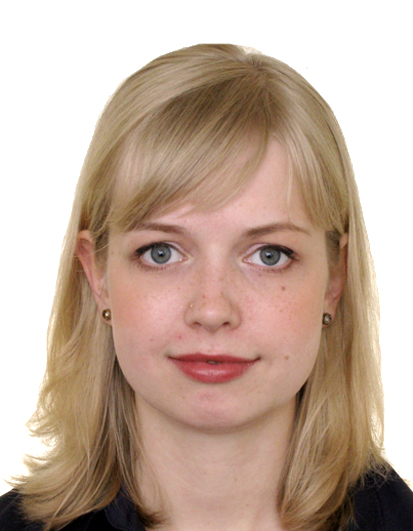Anastasia Zelenina
 | Anastasiya Zelenina IMTEK, University of Freiburg, Nanotechnology Tel.: +49 (0)761 203 7424 |
Curriculum Vitae
Born in USSR, Novosibirsk, 1988
Place of studies:
Russia, Novosibirsk State University, semiconductor physics
Practical and scientific experience
Jul.2009 – Sept.2009 CERN
Measure the collected charge of silicon detectors by ALIBAVA system
Publications
- Zelenina A.A.. Visualization of Germanium nanoclusters by AFM method. In: XLVII International Scientific Students Conference «Students and Progress in Science and Technology» Novosibirsk, Russia, April 11–15, 142 (in Russian only) 2009.
- Zelenina A.A., Kochubei S.A., Volodin V.A. Pulsed laser crystallization of the films A-Si:H for devices of wide-screen electronics. In: Photonics and Optical Technologies, Novosibirsk, Russia, February 9-11, 26-27 (in Russian only) 2011.
- Zelenina A.A.. Hydrogen influence on pulsed crystallization of amorphous hydrogenated silicon films. In: XLIX International Scientific Students Conference «Students and Progress in Science and Technology» Novosibirsk, Russia, April 16–20 (in Russian only) 2011.
- Volodin V.A., Bugaev K.O., Marin D.V., Zelenina A.A., Nesterov D.V., Antonenko A.Kh., Kamaev G.N., Kochubei S.A., Cherkov A.G., Gutakovsky A.K., Fedina L.I., Neklyudova M.A., Latyshev A.V., Misiuk A.. 19th. Laser-assistant and furnace annealing crystallization of silicon-rich nitride based and Si-SiO2 multilayer nanostructures. In: International Symposium Nanostructures: physics and technology, Ekaterinburg, Russia, June 20-25 2011.
- Bugaev K.O., Zelenina A.A., Volodin V.A. Vibrational spectroscopy of chemical species in hydrogenated silicon and silicon-rich nitride based nanostructures. In: Internation Journal of spectroscopy (Accepted to print) 2011.
- ZELENINA A., DYAKOV S. A., HILLER D., GUTSCH S., TROUILLET V., BRUNS M., MIRABELLA S., LÖPER P., LOPEZ-CONESA L., LOPEZ-VIDRIER J., ESTRADE S., PEIRO F., GARRIDO B., BLÄSING J., KROST A., ZHIGUNOV D. M., ZACHARIAS M.: “Structural and optical properties of size controlled Si nanocrystals in Si3N4 matrix: The nature of photoluminescence peak shift”, Journal of Applied Physics 114, 184311, 2013.
Abstract of thesis
Increasing the absorption efficiency of Si NC based device structures
Nowadays most of the solar cells are first generation photovoltaic cells, based on thick silicon wafers (>100 μm). The cost of such first generation photovoltaic solar cells is quite high mostly because of silicon expense. One of the solutions for cheaper solar cells is to reduce the thickness of the solar cell and to create a cell based on thin silicon films. However, the reduction of thickness reduces the absorption and therefore the solar cells based on thin silicon films have a lower efficiency. There are several ways to increase the efficiency of thin solar cells. In my thesis I will concentrate on the detailed investigation of the combination of plasmonic and nanostructured elements with Si NC based absorber structures.
One way to increase the absorption of thin film solar cells is to create a tandem solar cell, which contains a top cell based on Si nanocrystals (Si-NCs) with different sizes embedded in a dielectric matrix. This approach of third generation photovoltaics is called ‘all-silicon’ tandem solar cell [1]. Each cell is designed to absorb a certain range of the solar spectrum and to decrease thermalization losses. The bandgap of the cells is changed by changing the nanocrystalline size. The size-controlled superlattice approach will be used to create nanocrystalline layers, as it allows controlling precisely the size and the density of Si-NCs. Initially, the approach was developed for SiO/SiO2 superlattices [2]. But the silicon dioxide is not a proper material for photovoltaic applications due to its large band-offset. The superlattice approach will be transferred to a matrix with lower band-offset, such as silicon nitride matrix. The used deposition technique for photovoltaic structures is plasma-enhanced chemical vapor deposition (PECVD) as it can be applied for mass production.
So, the first part of the thesis is realization and optimization of the size-controlled approach in SiNx/Si3N4 superlattice by PECVD. In order to get well-separated silicon nanocrystals in silicon nitride matrix, suitable deposition conditions for stoichiometric silicon nitride (Si3N4) and silicon rich nitride (SiNx) have to be found. The silicon excess is changed by changing the ratio of precursor gases. The stoichiometry of the films is investigated by several techniques, such as ellipsometry, X-ray photoelectron spectroscopy and Rutherford backscattering spectrometry. The approach will be optimized for Si nanocrystal size and PL/absorption properties. To increase the light trapping in such Si NC based structures plasmonic structuring [3] will be tested. Different approaches will be used and evaluated.
1. M.A. Green, E.-C. Cho, y.-H. Cho, E. Pink, T. Trupke, K.-L. Lin, T. Fangsuwannarak, T. Puzzer, G. Conibeer, and R. Corkish, in Proceedings of the 20th European Photovoltaic Solar Energy Conference and Exhibition, p.3, Barcelona, Spain, June (2005) 72.
2. M. Zacharias, J. Heitmann, R. Scholz, U. Kahler, M. Schmidt, J. Blasing, Appl. Phys. Lett. 80 (2002) 661.
3. H. A. Atwater, A. Polman, Nature Materials 9 (2010) 205.

